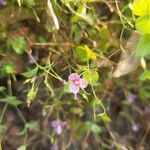Rather diffuse herb with ±fibrous roots. Stem erect, much-branched above, 10–60 cm high. Basal leaves usually absent at flowering. Stem leaves shortly petiolate becoming sessile upwards, broadly ovate, widest at c. 1/3 from base, to 35 mm long, 25 mm wide, obtuse to shortly acuminate, prominently 3-nerved. Inflorescence a very open diffuse dichasium; pedicels 5–8 mm long, with minute bracteoles. Flowers 4-merous, 3–3.5 mm diam. Calyx lobes 1–1.5 mm long. Corolla pink; tube c. 4 mm long; lobes c. 1–1.5 mm long. Style c. 1.5 mm long; stigmas revolute. Capsule c. 3–4 mm long. Seeds c. 0.2 mm long, 0.15 mm wide, reticulate-rugose, yellowish to reddish brown.
Annuals, to 30 cm tall, glabrous throughout. Stems branched from base, lower internodes winged, upper subterete. Leaves sessile; basal leaves ovate to broadly lanceolate, 1.8-2.4 × 0.8-1.8 cm, base truncate to cuneate, apex acute; veins 3-5, slender. Cymes lax, spreading; bracts to 2 × 0.5 mm. Pedicel to 1 mm, narrowly winged. Calyx to 5 mm; tube narrowly cylindric, to 3.5 mm; lobes linear-lanceolate, to 1.5 mm, apex acuminate. Corolla pale purple to pink, salverform, tube to 8 mm; lobes oblong, 2.5-5 mm. Fertile stamens 2 or 3, shorter than corolla tube. Sterile stamens 1 or 2, ca. as long as tube. Capsules linear-ovoid, 4-6 mm.
A herb. It is erect and grows each year from seed. It grows 35-70 cm tall. The stem is slender and 4 angled. The lower leaves have short stalks and the upper leaves do not have stalks. The leaves are 1-3 cm long by 0.5-1.5 cm wide. They are narrowly oval and wedge shaped at the base. There are many pink or white flowers.
Upper leaves sessile, the lower shortly petiolate; petiole up to 5 mm. long; lamina 1–3 (4) x 0.5–1.5 cm., ovate-elliptic to elliptic, acute at the apex, largely cuneate at the base, 3–5 nerved from the base, glabrous.
Flowers very numerous, pink, mauve or white, in lax somewhat diffuse, leafy cymes; bracts 4–8 x 2–5 mm., sessile, ovate, acute; pedicels 5–15 mm. long, filiform, not winged.
Calyx tube 4–5 mm. long, narrow, scarcely swollen towards the base, not winged; teeth subulate; 1.5–2 mm. long.
Ovary 0.3–0.4 mm. long, cylindric; style 1–1.5 mm. long, linear; stigmatic lobes, 0.4 mm. long.
Filaments 0.4–0.9 mm. long; anthers 0.25–0.35 x 0.25 mm., ellipsoid; sterile stamens 1–2.
Corolla tube 5–6 mm. long; lobes 1.5–2 x 1–1.5 mm., unequal, ovate obtuse.
Seeds, 0.2 mm. in diam., numerous; testa minutely faveolate.
Annual erect herb, up to 35 (70) cm. tall, much branched.
A much-branched many-flowered inflorescence
Stem slender, 4-angled, glabrous.
Capsule 4–5 mm. long, cylindric.
Erect herb up to 2 ft. high
Flowers white or lilac.

